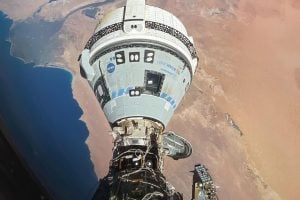
Boeing’s Starliner spacecraft’s return mission to Earth has been delayed due to issues with its thrusters, extending two American astronauts’ stay on the International Space Station while engineers work on the problem.
Patrick Binning, an expert in space systems and missions, weighs in on the situation. Binning serves as chair of the Whiting School of Engineering’s Engineering for Professionals‘ Space Systems Engineering program and mission area executive for National Security Space at Johns Hopkins Applied Physics Laboratory.
News reports have described the two astronauts as “stranded” and suggest they need to be rescued. How accurately does this characterize their situation, and what are the real implications of this delay?
Let’s start with the fact that a rescue mission in this case is totally unnecessary. The two astronauts—Butch Wilmore and Sunita Williams—who arrived at the International Space Station (ISS) in Boeing’s Starliner spacecraft are not stranded, and neither are the seven other astronauts on the ISS (five Americans and two Russians). Not only is Starliner capable of returning to Earth with its passengers, but the two other spacecraft docked at the ISS—SpaceX’s Dragon Endeavor and the Soyuz MS-25 crew ship—are also capable of returning astronauts to Earth.
NASA has delayed Starliner’s planned return date to collect more data on the spacecraft as a result of the unexpected performance of a few of the thrusters, along with a reported unexpected slow fuel leak. Let’s remember that going to space is hard. And human spaceflight is even more difficult. The design of Starliner certainly has many backup systems which made its arrival to the ISS successful. But even with backup systems, it’s important to understand unexpected conditions, which is why NASA is collecting more data.
Additionally, the ongoing testing is on a part of Starliner called the “service module” which will not return to Earth. The service module will separate from Starliner and burn up in the atmosphere which makes it unable to be inspected after the astronauts land safely. Hence, it is even more important to collect as much test data as possible.
As for the question of rescue operations, this is entirely a plausible scenario in the future for which NASA is likely to have contingencies. It is a scenario that needs to be explored and understood as humans begin to live and work on the moon and in nearby lunar space. Rescue operations are typically the domain of the military, such as the example of needing to rescue astronauts who unexpectedly splash down in the ocean after an aborted space launch. At this time, the U.S. military does not have a rescue capability to reach Earth’s orbit nor to reach the moon. NASA and the Space Force must start thinking through rescue operations as Americans and other nations start to live and work on the moon and in lunar orbit.
Do you think the Starliner incident will influence future spacecraft design and emergency protocols, particularly in the context of balancing crew safety with mission objectives?
I don’t see a need to change any current or future emergency protocols as a result of the current Starliner challenges. I do think NASA and Boeing will be taking a hard look at Boeing’s ground test procedures and approaches. All spacecraft developers make a great effort to “test as you fly” so that anomalous conditions on space systems are detected before launch. It’s obvious that Boeing’s test program was inadequate at capturing the current conditions, which is also why more on-orbit test data must be collected.
What emerging technologies or innovations could be crucial in preventing or mitigating similar incidents in future crewed space missions?
I think NASA and the Space Force, with Congressional support, need to explore technologies, authorities, and rescue operations to safely return stranded American astronauts from space. A rescue might be needed from low Earth orbit, from cislunar space (the space between the Earth and the moon), or from the lunar surface. It is improbable that there will not be a need for a rescue operation of stranded humans in space at some point in the future. One needs to only look back at Apollo 13 in April 1970 to see the types of conditions that are likely to occur with astronauts in need of rescue. America has an obligation, ingenuity, and technological sophistication to ensure the safe return of all humans to back to the Earth.